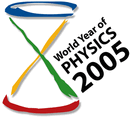Assessment |
Biopsychology |
Comparative |
Cognitive |
Developmental |
Language |
Individual differences |
Personality |
Philosophy |
Social |
Methods |
Statistics |
Clinical |
Educational |
Industrial |
Professional items |
World psychology |
Biological: Behavioural genetics · Evolutionary psychology · Neuroanatomy · Neurochemistry · Neuroendocrinology · Neuroscience · Psychoneuroimmunology · Physiological Psychology · Psychopharmacology (Index, Outline)
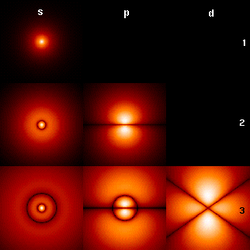
The first few hydrogen atom electron orbitals shown as cross-sections with color-coded probability density.
Physics (from the Greek, φύσις (phúsis), "nature" and φυσικός (phusikós), "natural"), the most fundamental physical science, is concerned with the underlying principles of the natural world. Consequently, physics deals with the elementary constituents of the Universe and their interactions, as well as the analysis of systems which are best understood in terms of these fundamental principles.
Introduction[]
Discoveries in physics find applications throughout the other natural sciences as they regard the basic constituents of the Universe. Some of the phenomena studied in physics, such as the phenomenon of conservation of energy, are common to all material systems. These are often referred to as laws of physics. Others, such as superconductivity, stem from these laws, but are not laws themselves because they only appear in some systems. Physics is often said to be the "fundamental science" (chemistry is sometimes included), because each of the other sciences (biology, chemistry, geology, material science, engineering, medicine etc.) deals with particular types of material systems that obey the laws of physics. For example, chemistry is the science of matter (such as atoms and molecules) and the chemical substances that they form in the bulk. The structure, reactivity, and properties of a chemical compound are determined by the properties of the underlying molecules, which can be described by areas of physics such as quantum mechanics (called in this case quantum chemistry), thermodynamics, and electromagnetism. (Refer to Branches of physics)
Physics is closely related to mathematics, which provides the logical framework in which physical laws can be precisely formulated and their predictions quantified. Physical definitions, models and theories are invariably expressed using mathematical relations. A key difference between physics and mathematics is that because physics is ultimately concerned with descriptions of the material world, it tests its theories by observations (called experiments), whereas mathematics is concerned with abstract logical patterns not limited by those observed in the real world (because the real world is limited in the number of dimensions and in many other ways it does not have to correspond to richer mathematical structures). The distinction, however, is not always clear-cut. There is a large area of research intermediate between physics and mathematics, known as mathematical physics.
Physics attempts to describe the natural world by the application of the scientific method. Natural philosophy, its counterpart, is the study of the changing world by philosophy which has been also called "physics" since classical times to at least up to its separation from philosophy as a positive science in the 19th century. Mixed questions, of which solutions can be attempted through the applications of both disciplines (e.g. the divisibility of the atom) can involve natural philosophy in physics the science and vice versa.
Classical, quantum and modern physics[]
- Further information: Classical physics, Quantum physics, Modern physics, Semiclassical
Since the construction of quantum mechanics in the early twentieth century, it generally became evident to the physical community that it would be preferable for every known description of Nature to be quantized, that is, to follow the postulates of quantum mechanics. To this effect, all results that were not quantized are called classical: this includes the special and general theories of relativity. Simply because a result is classical does not mean that it was discovered before the advent of quantum mechanics. Classical theories are, generally, much easier to work with and much research is still being conducted on them without the express aim of quantization. However, there exist problems in physics in which classical and quantum aspects must be combined to attain some approximation or limit that may acquire several forms as the passage from classical to quantum mechanics is often difficult — such problems are termed semiclassical.
However, because relativity and quantum mechanics provide the most complete known description of fundamental interactions, and because the changes brought by these two frameworks to the physicist's world view were revolutionary, the term modern physics is used to describe physics which relies on these two theories. Colloquially, modern physics can be described as the physics of extremes: from systems at the extremely small (atoms, nuclei, fundamental particles) to the extremely large (the Universe) and of the extremely fast (relativity).
Branches of physics of interest to psychologists[]
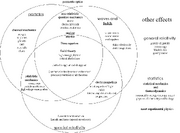
Classification of physics fields by the types of effects that need to be accounted for
Physicists study a wide range of physical phenomena, from quarks to black holes, from individual atoms to the many-body systems of superconductors.
Central theories[]
While physics deals with a wide variety of systems, there are certain theories that are used by all physicists. Each of these theories were experimentally tested numerous times and found correct as an approximation of Nature (within a certain domain of validity). For instance, the theory of classical mechanics accurately describes the motion of objects, provided they are much larger than atoms and moving at much less than the speed of light. These theories continue to be areas of active research; for instance, a remarkable aspect of classical mechanics known as chaos was discovered in the 20th century, three centuries after the original formulation of classical mechanics by Isaac Newton (1642–1727). These "central theories" are important tools for research into more specialized topics, and any physicist, regardless of his or her specialization, is expected to be literate in them.
| Theory | Major subtopics | Concepts |
|---|---|---|
| Classical mechanics | Newton's laws of motion, Lagrangian mechanics, Hamiltonian mechanics, Kinematics, Statics, Dynamics, Chaos theory, Acoustics, Fluid dynamics, Continuum mechanics | Density, Dimension, Gravity, Space, Time, Motion, Length, Position, Velocity, Acceleration, Mass, Momentum, Force, Energy, Angular momentum, Torque, Conservation law, Harmonic oscillator, Wave, Work, Power, Harmonic oscillator |
| Electromagnetism | Electrostatics, Electrodynamics, Electricity, Magnetism, Maxwell's equations, Optics | Capacitance, Electric charge, Current, Electrical conductivity, Electric field, Electric permittivity, Electrical resistance, Electromagnetic field, Electromagnetic induction, Electromagnetic radiation, Gaussian surface, Magnetic field, Magnetic flux, Magnetic monopole, Magnetic permeability |
| Thermodynamics and Statistical mechanics | Heat engine, Kinetic theory | Boltzmann's constant, Conjugate variables, Enthalpy, Entropy, Equation of state, Equipartition theorem, Free energy, Heat, Ideal gas law, Internal energy, Laws of thermodynamics, Irreversible process, Partition function, Pressure, Reversible process, Spontaneous process, State function, Statistical ensemble, Temperature, Thermodynamic equilibrium, Thermodynamic potential, Thermodynamic processes, Thermodynamic state, Thermodynamic system, Viscosity |
| Quantum mechanics | Path integral formulation, Scattering theory, Schrödinger equation, Quantum field theory, Quantum statistical mechanics | Adiabatic approximation, Correspondence principle, Free particle, Hamiltonian, Hilbert space, Identical particles, Matrix Mechanics, Planck's constant, Operators, Quanta, Quantization, Quantum entanglement, Quantum harmonic oscillator, Quantum number, Quantum tunneling, Schrödinger's cat, Dirac equation, Spin, Wavefunction, Wave mechanics, Wave-particle duality, Zero-point energy, Pauli Exclusion Principle, Heisenberg Uncertainty Principle |
| Theory of relativity | Special relativity, General relativity, Einstein field equations | Covariance, Einstein manifold, Equivalence principle, Four-momentum, Four-vector, General principle of relativity, Geodesic motion, Gravity, Gravitoelectromagnetism, Inertial frame of reference, Invariance, Length contraction, Lorentzian manifold, Lorentz transformation, Metric, Minkowski diagram, Minkowski space, Principle of Relativity, Proper length, Proper time, Reference frame, Rest energy, Rest mass, Relativity of simultaneity, Spacetime, Special principle of relativity, Speed of light, Stress-energy tensor, Time dilation, Twin paradox, World line |
Major fields[]

A magnet levitating above a high-temperature superconductor (with boiling liquid nitrogen underneath), demonstrating the Meissner effect.
Contemporary research in physics is divided into several distinct fields that study different aspects of the material world. Condensed matter physics, by most estimates the largest single field of physics, is concerned with how the properties of bulk matter, such as the ordinary solids and liquids we encounter in everyday life, arise from the properties and mutual interactions of the constituent atoms. The field of atomic, molecular, and optical physics deals with the behavior of individual atoms and molecules, and in particular the ways in which they absorb and emit light. Since the 20th century, the individual fields of physics have become increasingly specialized, and nowadays it is not uncommon for physicists to work in a single field for their entire careers. "Universalists" like Albert Einstein (1879–1955) who were comfortable working in multiple fields of physics, are now very rare.
| Field | Subfields | Major theories | Concepts | |
|---|---|---|---|---|
| Gravitation physics, | Big Bang, Lambda-CDM model, Cosmic inflation, General relativity, Law of universal gravitation | Gravity, Gravitational radiation, | Atomic, molecular, and optical physics | Atomic physics, Molecular physics, Atomic and Molecular astrophysics, Chemical physics, Optics, Photonics | Quantum optics, Quantum chemistry, Quantum information science | Atom, Molecule, Diffraction, Electromagnetic radiation, Laser, Polarization, Spectral line |
| Particle physics | Nuclear physics, Particle physics phenomenology | Standard Model, Quantum field theory, Quantum chromodynamics, Electroweak theory, Effective field theory, Lattice field theory, Lattice gauge theory, Gauge theory, Supersymmetry, Grand unification theory, Superstring theory, M-theory | Fundamental force (gravitational, electromagnetic, weak, strong), Elementary particle, Spin, Antimatter, Spontaneous symmetry breaking, Brane, String, Quantum gravity, Theory of everything, Vacuum energy | |
| Condensed matter physics | Solid state physics, Nanoscale and Mesoscopic physics, Polymer physics | Many-body theory | Phases (gas, liquid, solid, Electrical conduction, Magnetism, Self-organization, Spin, Spontaneous symmetry breaking |
Theoretical and experimental physics[]
The culture of physics research differs from the other sciences in the separation of theory and experiment. Since the 20th century, most individual physicists have specialized in either theoretical physics or experimental physics. The great Italian physicist Enrico Fermi (1901–1954), who made fundamental contributions to both theory and experimentation in nuclear physics, was a notable exception. In contrast, almost all the successful theorists in biology and chemistry (e.g. American quantum chemist and biochemist Linus Pauling) have also been experimentalists, though this is changing as of late.
Roughly speaking, theorists seek to develop through abstractions and mathematical models theories that can both describe and interpret existing experimental results and successfully predict future results, while experimentalists devise and perform experiments to explore new phenomena and test theoretical predictions. Although theory and experiment are developed separately, they are strongly dependent on each other. However, theoretical research in physics may further be considered to draw from mathematical physics and computational physics in addition to experimentation. Progress in physics frequently comes about when experimentalists make a discovery that existing theories cannot account for, necessitating the formulation of new theories. Likewise, ideas arising from theory often inspire new experiments. In the absence of experiment, theoretical research can go in the wrong direction; this is one of the criticisms that has been leveled against M-theory, a popular theory in high-energy physics for which no practical experimental test has ever been devised.
Phenomenology[]
Phenomenology is intermediate between experiment and theory. It is more abstract and includes more logical steps than experiment, but is more directly tied to experiment than theory. The boundaries between theory and phenomenology, and between phenomenology and experiment, are somewhat fuzzy and to some extent depend on the understanding and intuition of the scientist describing these. An example is Einstein's 1905 paper on the photoelectric effect, "On a Heuristic Viewpoint Concerning the Production and Transformation of Light".
Applied physics[]
Applied physics is physics that is intended for a particular technological or practical use, as for example in engineering, as opposed to basic research. This approach is similar to that of applied mathematics. Applied physics is rooted in the fundamental truths and basic concepts of the physical sciences but is concerned with the utilization of scientific principles in practical devices and systems, and in the application of physics in other areas of science. "Applied" is distinguished from "pure" by a subtle combination of factors such as the motivation and attitude of researchers and the nature of the relationship to the technology or science that may be affected by the work. [1]
| Branches of Applied Physics |
|---|
| Accelerator physics, Acoustics, Agrophysics, Biophysics, Chemical Physics, Communication Physics, Econophysics, Engineering physics, Fluid dynamics, Geophysics, Medical physics, Nanotechnology, Optoelectronics, Photovoltaics, Physical chemistry, Physics of computation, Quantum chemistry, Quantum information science, Vehicle dynamics |
History[]
- Main article: History of physics
- Further information: Famous physicists, Nobel Prize in physics
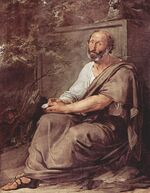
Since antiquity, people have tried to understand the behavior of matter: why unsupported objects drop to the ground, why different materials have different properties, and so forth. The character of the Universe was also a mystery, for instance the Earth and the behavior of celestial objects such as the Sun and the Moon. Several theories were proposed, most of which were wrong. These first theories were largely couched in philosophical terms, and never verified by systematic experimental testing as is popular today. The works of Ptolemy and Aristotle, however, were also not always found to match everyday observations. There were exceptions and there are anachronisms - for example, Indian philosophers and astronomers gave many correct descriptions in atomism and astronomy, and the Greek thinker Archimedes derived many correct quantitative descriptions of mechanics and hydrostatics.
The willingness to question previously held truths and search for new answers eventually resulted in a period of major scientific advancements, now known as the Scientific Revolution of the late 17th century. The precursors to the scientific revolution can be traced back to the important developments made in India and Persia, including the elliptical model of the planets based on the heliocentric solar system of gravitation developed by Indian mathematician-astronomer Aryabhata; the basic ideas of atomic theory developed by Hindu and Jaina philosophers; the theory of light being equivalent to energy particles developed by the Indian Buddhist scholars Dignāga and Dharmakirti; the optical theory of light developed by Persian scientist Alhazen; the Astrolabe invented by the Persian Mohammad al-Fazari; and the significant flaws in the Ptolemaic system pointed out by Persian scientist Nasir al-Din al-Tusi.
As the influence of the Islamic Caliphate expanded to Europe, the works of Aristotle preserved by the Arabs, and the works of the Indians and Persians, became known in Europe by the 12th and 13th centuries. This eventually lead to the scientific revolution which culminated with the publication of the Philosophiae Naturalis Principia Mathematica in 1687 by the mathematician, physicist, alchemist and inventor Sir Isaac Newton (1643-1727).
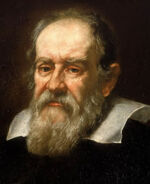
Galileo
The Scientific Revolution is held by most historians (e.g., Howard Margolis) to have begun in 1543, when the first printed copy of Nicolaus Copernicus's De Revolutionibus (most of which had been written years prior but whose publication had been delayed) was brought to the influential Polish astronomer from Nuremberg.
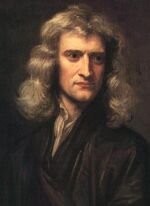
Sir Isaac Newton
Further significant advances were made over the following century by Galileo Galilei, Christiaan Huygens, Johannes Kepler, and Blaise Pascal. During the early 17th century, Galileo pioneered the use of experimentation to validate physical theories, which is the key idea in modern scientific method. Galileo formulated and successfully tested several results in dynamics, in particular the Law of Inertia. In 1687, Newton published the Principia, detailing two comprehensive and successful physical theories: Newton's laws of motion, from which arise classical mechanics; and Newton's Law of Gravitation, which describes the fundamental force of gravity. Both theories agreed well with experiment. The Principia also included several theories in fluid dynamics. Classical mechanics was re-formulated and extended by Leonhard Euler, French mathematician Joseph-Louis Comte de Lagrange, Irish mathematical physicist William Rowan Hamilton, and others, who produced new results in mathematical physics. The law of universal gravitation initiated the field of astrophysics, which describes astronomical phenomena using physical theories.
After Newton defined classical mechanics, the next great field of inquiry within physics was the nature of electricity. Observations in the 17th and 18th century by scientists such as Robert Boyle, Stephen Gray, and Benjamin Franklin created a foundation for later work. These observations also established our basic understanding of electrical charge and current.
In 1821, the English physicist and chemist Michael Faraday integrated the study of magnetism with the study of electricity. This was done by demonstrating that a moving magnet induced an electric current in a conductor. Faraday also formulated a physical conception of electromagnetic fields. James Clerk Maxwell built upon this conception, in 1864, with an interlinked set of 20 equations that explained the interactions between electric and magnetic fields. These 20 equations were later reduced, using vector calculus, to a set of four equations by Oliver Heaviside.
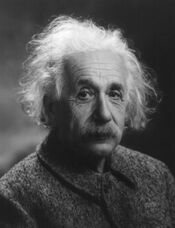
In addition to other electromagnetic phenomena, Maxwell's equations also can be used to describe light. Confirmation of this observation was made with the 1888 discovery of radio by Heinrich Hertz and in 1895 when Wilhelm Roentgen detected X rays. The ability to describe light in electromagnetic terms helped serve as a springboard for Albert Einstein's publication of the theory of special relativity in 1905. This theory combined classical mechanics with Maxwell's equations. The theory of special relativity unifies space and time into a single entity, spacetime. Relativity prescribes a different transformation between reference frames than classical mechanics; this necessitated the development of relativistic mechanics as a replacement for classical mechanics. In the regime of low (relative) velocities, the two theories agree. Einstein built further on the special theory by including gravity into his calculations, and published his theory of general relativity in 1915.
One part of the theory of general relativity is Einstein's field equation. This describes how the stress-energy tensor creates curvature of spacetime and forms the basis of general relativity. Further work on Einstein's field equation produced results which predicted the Big Bang, black holes, and the expanding universe. Einstein believed in a static universe and tried (and failed) to fix his equation to allow for this. However, by 1929 Edwin Hubble's astronomical observations suggested that the universe is expanding.
From the late 17th century onwards, thermodynamics was developed by physicist and chemist Boyle, Young, and many others. In 1733, Bernoulli used statistical arguments with classical mechanics to derive thermodynamic results, initiating the field of statistical mechanics. In 1798, Thompson demonstrated the conversion of mechanical work into heat, and in 1847 Joule stated the law of conservation of energy, in the form of heat as well as mechanical energy. Ludwig Boltzmann, in the 19th century, is responsible for the modern form of statistical mechanics.
In 1895, Röntgen discovered X-rays, which turned out to be high-frequency electromagnetic radiation. Radioactivity was discovered in 1896 by Henri Becquerel, and further studied by Marie Curie, Pierre Curie, and others. This initiated the field of nuclear physics.
In 1897, Joseph J. Thomson discovered the electron, the elementary particle which carries electrical current in circuits. In 1904, he proposed the first model of the atom, known as the plum pudding model. (The existence of the atom had been proposed in 1808 by John Dalton.)
These discoveries revealed that the assumption of many physicists that atoms were the basic unit of matter was flawed, and prompted further study into the structure of atoms.
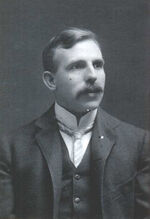
Ernest Rutherford
In 1911, Ernest Rutherford deduced from scattering experiments the existence of a compact atomic nucleus, with positively charged constituents dubbed protons. Neutrons, the neutral nuclear constituents, were discovered in 1932 by Chadwick. The equivalence of mass and energy (Einstein, 1905) was spectacularly demonstrated during World War II, as research was conducted by each side into nuclear physics, for the purpose of creating a nuclear bomb. The German effort, led by Heisenberg, did not succeed, but the Allied Manhattan Project reached its goal. In America, a team led by Fermi achieved the first man-made nuclear chain reaction in 1942, and in 1945 the world's first nuclear explosive was detonated at Trinity site, near Alamogordo, New Mexico.
In 1900, Max Planck published his explanation of blackbody radiation. This equation assumed that radiators are quantized, which proved to be the opening argument in the edifice that would become quantum mechanics. By introducing discrete energy elvels, Planck, Einstein, Niels Bohr, and others developed quantum theories to explain various anomalous experimental results. Quantum mechanics was formulated in 1925 by Heisenberg and in 1926 by Schrödinger and Paul Dirac, in two different ways that both explained the preceding heuristic quantum theories. In quantum mechanics, the outcomes of physical measurements are inherently probabilistic; the theory describes the calculation of these probabilities. It successfully describes the behavior of matter at small distance scales. During the 1920s Schrödinger, Heisenberg, and Max Born were able to formulate a consistent picture of the chemical behavior of matter, a complete theory of the electronic structure of the atom, as a byproduct of the quantum theory.
Quantum field theory was formulated in order to extend quantum mechanics to be consistent with special relativity. It was devised in the late 1940s with work by Richard Feynman, Julian Schwinger, Sin-Itiro Tomonaga, and Freeman Dyson. They formulated the theory of quantum electrodynamics, which describes the electromagnetic interaction, and successfully explained the Lamb shift. Quantum field theory provided the framework for modern particle physics, which studies fundamental forces and elementary particles.
Chen Ning Yang and Tsung-Dao Lee, in the 1950s, discovered an unexpected asymmetry in the decay of a subatomic particle. In 1954, Yang and Robert Mills then developed a class of gauge theories which provided the framework for understanding the nuclear forces. The theory for the strong nuclear force was first proposed by Murray Gell-Mann. The electroweak force, the unification of the weak nuclear force with electromagnetism, was proposed by Sheldon Lee Glashow, Abdus Salam and Steven Weinberg and confirmed in 1964 by James Watson Cronin and Val Fitch. This led to the so-called Standard Model of particle physics in the 1970s, which successfully describes all the elementary particles observed to date.
Quantum mechanics also provided the theoretical tools for condensed matter physics, whose largest branch is solid state physics. It studies the physical behavior of solids and liquids, including phenomena such as crystal structures, semiconductivity, and superconductivity. The pioneers of condensed matter physics include Felix Bloch, who created a quantum mechanical description of the behavior of electrons in crystal structures in 1928. The transistor was developed by physicists John Bardeen, Walter Houser Brattain and William Bradford Shockley in 1947 at Bell Telephone Laboratories.
The two themes of the 20th century, general relativity and quantum mechanics, appear inconsistent with each other. General relativity describes the universe on the scale of planets and solar systems while quantum mechanics operates on sub-atomic scales. This challenge is being attacked by string theory, which treats spacetime as composed, not of points, but of one-dimensional objects, strings. Strings have properties like a common string (e.g., tension and vibration). The theories yield promising, but not yet testable results. The search for experimental verification of string theory is in progress.
Future directions[]
- Main article: Unsolved problems in physics
Research in physics is progressing constantly on a large number of fronts, and is likely to do so for the foreseeable future.
In condensed matter physics, the biggest unsolved theoretical problem is the explanation for high-temperature superconductivity. Strong efforts, largely experimental, are being put into making workable spintronics and quantum computers.
In particle physics, the first pieces of experimental evidence for physics beyond the Standard Model have begun to appear. Foremost amongst these are indications that neutrinos have non-zero mass. These experimental results appear to have solved the long-standing solar neutrino problem in solar physics. The physics of massive neutrinos is currently an area of active theoretical and experimental research. In the next several years, particle accelerators will begin probing energy scales in the TeV range, in which experimentalists are hoping to find evidence for the Higgs boson and supersymmetric particles.
Theoretical attempts to unify quantum mechanics and general relativity into a single theory of quantum gravity, a program ongoing for over half a century, have not yet borne fruit. The current leading candidates are M-theory, superstring theory and loop quantum gravity.
Many astronomical and cosmological phenomena have yet to be satisfactorily explained, including the existence of ultra-high energy cosmic rays, the baryon asymmetry, the acceleration of the universe and the anomalous rotation rates of galaxies.
Although much progress has been made in high-energy, quantum, and astronomical physics, many everyday phenomena, involving complexity, chaos, or turbulence are still poorly understood. Complex problems that seem like they could be solved by a clever application of dynamics and mechanics, such as the formation of sandpiles, nodes in trickling water, the shape of water droplets, mechanisms of surface tension catastrophes, or self-sorting in shaken heterogeneous collections are unsolved. These complex phenomena have received growing attention since the 1970s for several reasons, not least of which has been the availability of modern mathematical methods and computers which enabled complex systems to be modeled in new ways. The interdisciplinary relevance of complex physics has also increased, as exemplified by the study of turbulence in aerodynamics or the observation of pattern formation in biological systems. In 1932, Horace Lamb correctly prophesied:
I am an old man now, and when I die and go to heaven there are two matters on which I hope for enlightenment. One is quantum electrodynamics, and the other is the turbulent motion of fluids. And about the former I am rather optimistic.
See also[]
- Biomechanics
- Biophysics
- Chemistry
- Electrophysiology
- Magnetism
- Mathematics
- Physicists
- Psychophysics
- Relativism
Notes[]
- Alpher, Herman, and Gamow. Nature 162,774 (1948). Wilson's 1978 Nobel lecture
- C.S. Wu's contribution to the overthrow of the conservation of parity
- Yang, Mills 1954 Physical Review 95, 631; Yang, Mills 1954 Physical Review 96, 191.
Further reading[]
Popular Reading[]
- Feynman, Richard (1994). Character of Physical Law, Random House. ISBN 0679601279.
- Greene, Brian (2000). The Elegant Universe: Superstrings, Hidden Dimensions, and the Quest for the Ultimate Theory, Vintage. ISBN 0375708111.
- Walker, Jearl (1977). The Flying Circus of Physics, Wiley. ISBN 047102984X.
- Leggett, Anthony (1988). The Problems of Physics, Oxford University Press. ISBN 0192891863.
- Rogers, Eric (1960). Physics for the Inquiring Mind: The Methods, Nature, and Philosophy of Physical Science, Princeton University Press. ISBN 069108016X.
- Coward, David (1988). An Advanced Guide to Physics, Bantam. ISBN 068108016X.
University Level Textbooks[]
Introductory[]
- Feynman, Richard; Leighton, Robert; Sands, Matthew (1989). Feynman Lectures on Physics, Addison-Wesley. ISBN 0201510030.
- Feynman, Richard. Exercises for Feynman Lectures Volumes 1-3, Caltech. ISBN 2356487891.
- Knight, Randall (2004). Physics for Scientists and Engineers: A Strategic Approach, Benjamin Cummings. ISBN 0805386858.
- Resnick, Robert; Halliday, David; Walker, Jearl. Fundamentals of Physics.
- Hewitt, Paul (2001). Conceptual Physics with Practicing Physics Workbook (9th ed.), Addison Wesley. ISBN 0321052021.
- Giancoli, Douglas (2005). Physics: Principles with Applications (6th ed.), Prentice Hall. ISBN 0130606200.
- Serway, Raymond A.; Jewett, John W. (2004). Physics for Scientists and Engineers (6th ed.), Brooks/Cole. ISBN 0534408427.
- Tipler, Paul (2004). Physics for Scientists and Engineers: Mechanics, Oscillations and Waves, Thermodynamics (5th ed.), W. H. Freeman. ISBN 0716708094.
- Tipler, Paul (2004). Physics for Scientists and Engineers: Electricity, Magnetism, Light, and Elementary Modern Physics (5th ed.), W. H. Freeman. ISBN 0716708108.
- Wilson, Jerry; Buffa, Anthony (2002). College Physics (5th ed.), Prentice Hall. ISBN 0130676446.
- Schiller, Christoph (2005). Motion Mountain: The Free Physics Textbook.
- H. C. Verma (2005). Concepts of Physics, Bharti Bhavan. ISBN 8177091875.
Undergraduate[]
- Thornton, Stephen T.; Marion, Jerry B. (2003). Classical Dynamics of Particles and Systems (5th ed.), Brooks Cole. ISBN 0534408966.
- Griffiths, David J. (1998). Introduction to Electrodynamics (3rd ed.), Prentice Hall. ISBN 013805326X.
- Wangsness, Roald K. (1986). Electromagnetic Fields (2nd ed.), Wiley. ISBN 0471811866.
- Fowles, Grant R. (1989). Introduction to Modern Optics, Dover Publications. ISBN 0486659577.
- Hecht, Eugene (2001). Optics (4th ed.), Pearson Education. ISBN 0805385665.
- Schroeder, Daniel V. (1999). An Introduction to Thermal Physics, Addison Wesley. ISBN 0201380277.
- Kroemer, Herbert; Kittel, Charles (1980). Thermal Physics (2nd ed.), W. H. Freeman Company. ISBN 0716710889.
- Griffiths, David J. (2004). Introduction to Quantum Mechanics (2nd ed.), Prentice Hall. ISBN 013805326X.
- Liboff, Richard L. (2002). Introductory Quantum Mechanics, Addison-Wesley. ISBN 0805387145.
- Bohm, David (1989). Quantum Theory, Dover Publications. ISBN 0486659690.
- Eisberg, Robert; Resnick, Robert (1985). Quantum Physics of Atoms, Molecules, Solids, Nuclei, and Particles (2nd ed.), Wiley. ISBN 047187373X.
- Taylor, Edwin F.; Wheeler, John Archibald (1992). Spacetime Physics: Introduction to Special Relativity (2nd ed.), W.H. Freeman. ISBN 0716723271.
- Taylor, Edwin F.; Wheeler, John Archibald (2000). Exploring Black Holes: Introduction to General Relativity, Addison Wesley. ISBN 020138423X.
- Schutz, Bernard F. (1984). A First Course in General Relativity, Cambridge University Press. ISBN 0521277035.
- Bergmann, Peter G. (1976). Introduction to the Theory of Relativity, Dover Publications. ISBN 0486632822.
- Tipler, Paul; Llewellyn, Ralph (2002). Modern Physics (4th ed.), W. H. Freeman. ISBN 0716743450.
- Griffiths, David J. (1987). Introduction to Elementary Particles, Wiley, John & Sons, Inc. ISBN 0471603864.
- Perkins, Donald H. (1999). Introduction to High Energy Physics, Cambridge University Press. ISBN 0521621968.
- Povh, Bogdan (1995). Particles and Nuclei: An Introduction to the Physical Concepts, Springer-Verlag. ISBN 0387594396.
- Menzel, Donald Howard (1961). Mathematical Physics, Dover Publishications. ISBN 0486600564.
- Joos, Georg; Freeman, Ira M. (1987). Theoretical Physics, Dover Publications. ISBN 0486652270.
Graduate[]
- Landau, L. D.; Lifshitz, E. M. (1976). Course of Theoretical Physics, Butterworth-Heinemann. ISBN 0750628960.
- Morse, Philip; Feshbach, Herman (2005). Methods of Theoretical Physics, Feshbach Publishing. ISBN 0976202123.
- Arfken, George B.; Weber, Hans J. (2000). Mathematical Methods for Physicists (5th ed.), Academic Press. ISBN 0120598256.
- Goldstein, Herbert (2002). Classical Mechanics, Addison Wesley. ISBN 0201657023.
- Jackson, John D. (1998). Classical Electrodynamics (3rd ed.), Wiley. ISBN 047130932X.
- Landau, L. D.; Lifshitz, E. M. (1972). Mechanics and Electrodynamics, Vol. 1, Franklin Book Company, Inc. ISBN 008016739X.
- Huang, Kerson (1990). Statistical Mechanics, Wiley, John & Sons, Inc. ISBN 0471815187.
- Merzbacher, Eugen (1998). Quantum Mechanics, Wiley, John & Sons, Inc. ISBN 0471887021.
- Peskin, Michael E.; Schroeder, Daniel V. (1994). Introduction to Quantum Field Theory, Perseus Publishing. ISBN 0201503972.
- Thorne, Kip S.; Misner, Charles W.; Wheeler, John Archibald (1973). Gravitation, W.H. Freeman. ISBN 0716703440.
- Wald, Robert M. (1984). General Relativity, University of Chicago Press. ISBN 0226870332.
- Weinberg, Steven (1972). Gravitation and Cosmology: Principles and Applications of the General Theory of Relativity, John Wiley & Sons. ISBN 0471925675.
External links[]
| This page uses Creative Commons Licensed content from Wikipedia (view authors). |
